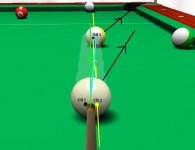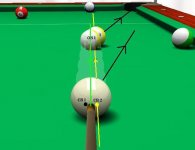Good point as well. But of course nothing will work (at least not consistently) if you don't put the cue ball exactly where you're intending. That's a totally different variable. For now, let's just assume that your stroke is dead on, and that you always hit the cue ball where you intend.
IJ is important, but it's also a good thing to check the accuracy of your IJ as well. An aiming system is a way to provide a system of checks and balances to your IJ. When you're pocketing "in the zone", it seems that IJ is the dominant factor when executing a cut shot. You just know where to aim, because it just "feels" right. But IJ is not an exact science, so you can wake up one morning and your IJ can be offset a millimeter or two in one direction. It may take several shots before you find out that you're consistently overcutting or undercutting the object ball. So the next step would be to compensate for the error, by shifting your IJ by an
estimated amount. I say "estimated" because this is also an intuitive judgment call. There's a chance you may overcompensate or undercompensate, and miss even more balls in the process. By the time you obtain the correct "feel" for the shot, you'll always second guess because it doesn't agree with the original IJ you woke up with in the morning.
However, if you have a reliable aiming system, this correction process can be a lot faster and less damaging. You simply just reconcile what your IJ tells you with what your aiming system tells you. If there's a discrepancy, then you know that you should always fall back on what your aiming system tells you (of course only if it's a reliable system). When you get into one of these funks, you can just turn off your IJ (at least just for aiming, cuz you still need IJ for touch and speed) and rely on your system. You'll at least have a better chance to compete during these off days, rather than living and dying by IJ.
But Colin brings up a good point...there will
always be some IJ when executing a shot, because there are no systems for speed, english, spin, and positioning...which is why you can't expect a programmed robot to consistenly beat Efren in 9ball.

Its exactly what he is doing. Why would anyone line up a straight shot by aiming off-center?



